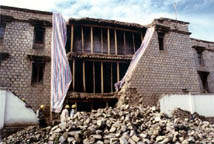|

work on
Juenpa House
|
In 1999, THF received funding from the German Society for Technical Cooperation to carry out "independent activities". Not only has GTZ numerous projects throughout China, but the long-term GTZ conservation activities in Nepal's historic Kathmandu valley have long been an inspiration to
THF.
One of the house communities that for some time requested THF help was that of Juenpa
House - click here
to go to the Juenpa House page (use your "back" button
to return here). Juenpa House is said to have been the site where grain was roasted and ground for the workers who built the Jokhang temple, and until some time ago a shrine in the house had preserved an original grinding stone. THF discovered that wood-eating beetles had damaged several supporting beams, causing serious settlement of the upper floor, reason enough to begin work on the site immediately after the tenants had temporarily moved out. Total spent so far: US$ 6,098.
|
GTZ also funded neighbourhood improvement costs in the core of the old city, such as Jamyang in the Shasarzur Conservation Area. In 1998, Zara Thiessen made a thorough survey and report for THF about the Jamyang complex, which is home to more 300 people. Built in the 18th century, the remaining eight courtyards that make up the complex have become very dilapidated, with some parts on the verge of collapse. Following the report's recommendations, THF has begun with structural improvement and new drainage systems for $3,339. The Jamyang work is seen by THF as a long-term rehabilitation project for this important component of the old city.
Barkor Corner Houses: three houses on the north-eastern corner of Barkor had partially collapsed in 1999 and were preemptively evacuated by the Barkor Neighbourhood Office. THF conducted a survey and made a rehabilitation proposal, with work scheduled to begin in early 2000.
 |
Bonshoe House
click here
to go to the Bonshoe House
page (use your "back" button to return here) |
The Bonshoe House: Bonshoe House, built around 1940, was so well-regarded in the city that when the parents of the 14th Dalai Lama came to Lhasa and were ennobled, the residence government built for them was modeled on Bonshoe. Bonshoe was also one of the first construction projects of THF master builder Migmar-la, who joined the stone masons as an apprentice. Unfortunately, Bonshoe was also one of several sites in 1999 which partially collapsed during the heavy summer rains. When THF was alerted by the Housing Department, German architect Beate Heyne developed a new frame work for the in-depth study and documentation of Bonshoe. Master Migmar-la and his master student, Loya, rebuilt the damaged walls and roof in traditional style. Total costs: US$3,314.
|

|
|
The Old Post Office
click here
to go to the Old Post Office page (use your "back"
button to return here) |
|

|
The Old Post
Office
in the 1940s |
The Old Post Office: established in the 1920s, the former Lhasa GPO (General Post Office) today houses several families, despite a collapse of the eastern wing some time ago. Half a century ago, arriving mail for Lhasa was distributed from here, and outward going letters and telegrammes were accepted. During a routine visit, THF discovered that wood-eating beetles had severely weakened the wooden ceiling between the ground and the upper floor to the point of impending collapse. Since the upper floor was inhabited, THF requested the Tengyeling Neighbourhood Committee Office to evacuate the building. After survey and planning work from THF, the work will be carried out in cooperation with Lhasa Cultural Relics Office. The Lhasa Number One Construction Company, which did the government restoration of Mindrochang House, has begun work on the Post Office under direct supervision by THF. US$14,448 have been spent so far.
Survey and planning work for all these projects amounted to $9,054. A handbook about the historic buildings located in the central Barkor area, in Chinese, Tibetan and English plus a new survey map of this area (soon to be listed as UNESCO World Heritage Site) was printed and distributed among Barkor residents and city officials, both as important documentation of the oldest part of Lhasa, and as part of an awareness campaign, with $6,500 GTZ funds (see chapter 8). Freshly-cut wood was bought for $10,065 and put in storage to season, to be used in 2000.
|





